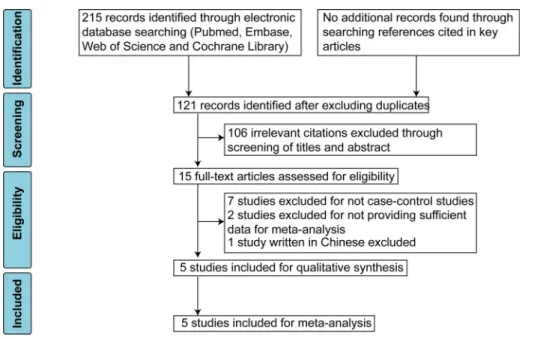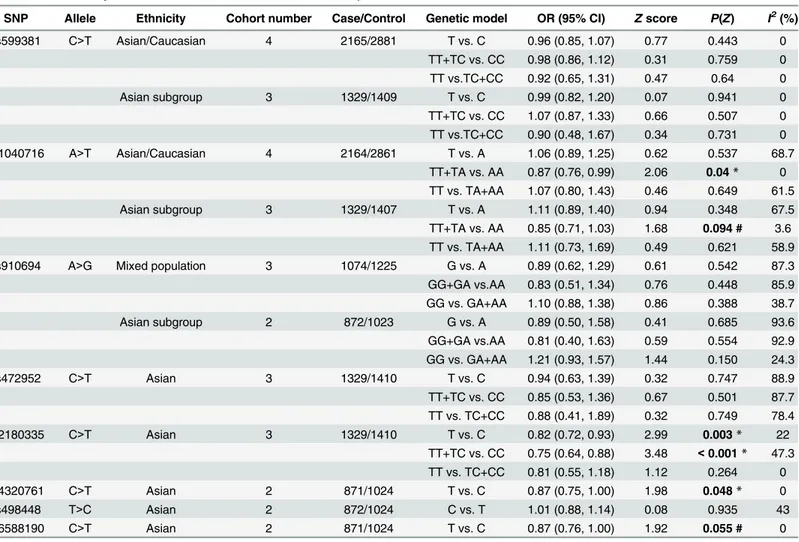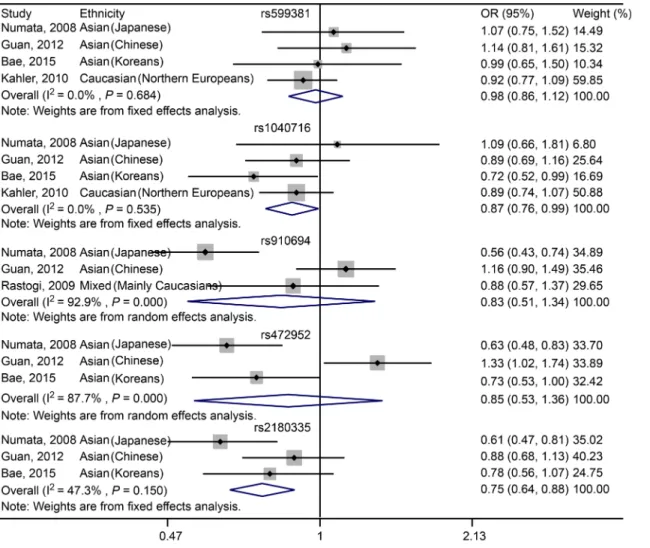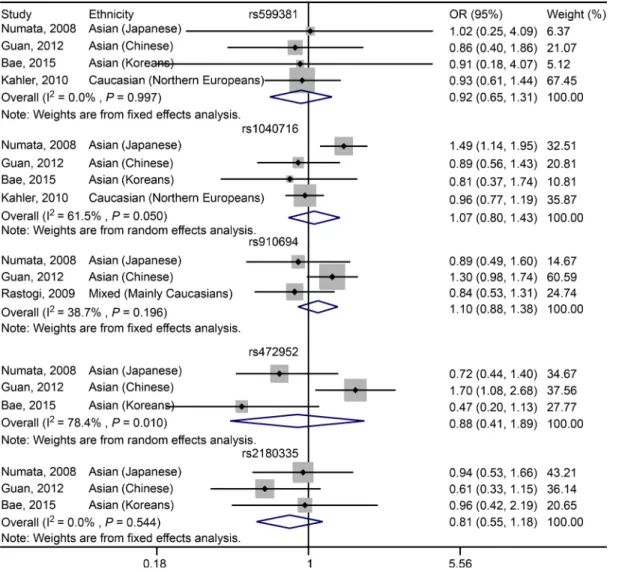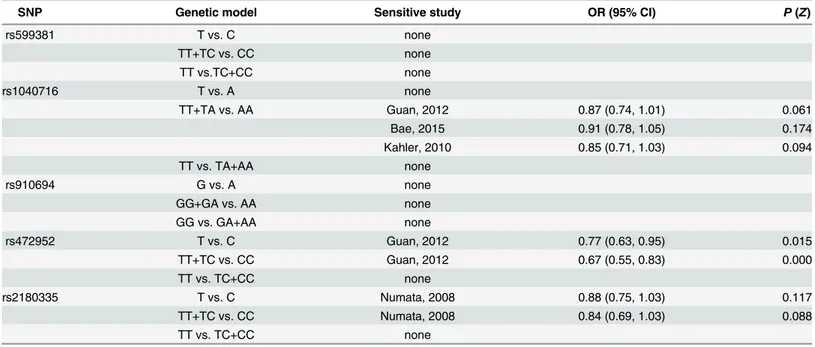Association of
PDE4B
Polymorphisms with
Susceptibility to Schizophrenia: A
Meta-Analysis of Case-Control Studies
Yanguo Feng, Dejun Cheng, Chaofeng Zhang, Yuchun Li, Zhiying Zhang, Juan Wang, Yuzhong Shi*
Department of Psychiatry, Henan Mental Hospital, The Second Affiliated Hospital of Xinxiang Medical University, Xinxiang, China
*syzscience123@163.com
Abstract
Background
ThePDE4Bsingle nucleotide polymorphisms (SNPs) have been reported to be associated with schizophrenia risk. However, current findings are ambiguous or even conflicting. To better facilitate the understanding the genetic role played byPDE4Bin susceptibility to schizophrenia, we collected currently available data and conducted this meta-analysis.
Methods
A comprehensive electronic literature searching of PubMed, Embase, Web of Science and Cochrane Library was performed. The association betweenPDE4BSNPs and schizophrenia was evaluated by odds ratios (ORs) and 95% confidence intervals (CIs) under allelic, domi-nant and recessive genetic models. The random effects model was utilized when high between-study heterogeneity (I2>50%) existed, otherwise the fixed effects model was used.
Results
Five studies comprising 2376 schizophrenia patients and 3093 controls were finally included for meta-analysis. The rs1040716 was statistically significantly associated with schizophrenia risk in Asian and Caucasian populations under dominant model (OR = 0.87, 95% CI: 0.76–0.99,P= 0.04). The rs2180335 was significantly related with schizophrenia risk in Asian populations under allelic (OR = 0.82, 95% CI: 0.72–0.93,P= 0.003) and domi-nant (OR = 0.75, 95% CI: 0.64–0.88,P<0.001) models. A significant association was also
observed between rs4320761 and schizophrenia in Asian populations under allelic model (OR = 0.87, 95% CI: 0.75–1.00,P= 0.048). In addition, a strong association tendency was found between rs6588190 and schizophrenia in Asian populations under allelic model (OR = 0.87, 95% CI: 0.76–1.00,P= 0.055).
Conclusion
This meta-analysis suggests thatPDE4BSNPs are genetically associated with susceptibil-ity to schizophrenia. However, due to limited sample size, more large-scale, multi-racial OPEN ACCESS
Citation:Feng Y, Cheng D, Zhang C, Li Y, Zhang Z, Wang J, et al. (2016) Association ofPDE4B Polymorphisms with Susceptibility to Schizophrenia: A Meta-Analysis of Case-Control Studies. PLoS ONE 11(1): e0147092. doi:10.1371/journal.pone.0147092
Editor:Robert M Lafrenie, Sudbury Regional Hospital, CANADA
Received:August 6, 2015
Accepted:December 26, 2015
Published:January 12, 2016
Copyright:© 2016 Feng et al. This is an open access article distributed under the terms of the
Creative Commons Attribution License, which permits unrestricted use, distribution, and reproduction in any medium, provided the original author and source are credited.
Data Availability Statement:All relevant data are within the paper and its Supporting Information files.
Funding:The authors have no support or funding to report.
association studies are needed to further clarify the genetic association between various PDE4Bvariants and schizophrenia.
Introduction
Susceptibility to schizophrenia has been considered to be inextricably related to genetic factors [1–4]. Twin studies have yielded heritability estimates of over 80% for schizophrenia, providing important genetic evidence for schizophrenia pathogenesis [5,6]. In particular, to pinpoint genetic vulnerability to schizophrenia, genome-wide association studies have identified a num-ber of single nucleotide polymorphisms (SNPs) within genes significantly associated with schizophrenia risk [7,8].
Among various candidate genes for schizophrenia, the genephosphodiesterase 4B(PDE4B), which is located on human chromosome 1 at 1p31 and composed of 17 exons spanning 580 kb [9], belongs toPDE4families. Like other adenosine 3’, 5’-monophosphate (cAMP) phosphodiesterases, PDE4B participates in cAMP signaling process by specifically inactivating cAMP [10]. Interestingly, mutations of fruit flyduncegene, encoding an ortholog of mammalian PDE4, resulted in high levels of cAMP and deficiencies in olfactory learning and memory [11].PDE4Bwas first implicated as a candidate risk gene for schizophrenia through investigating chromosomal abnormalities of two cous-ins, the proband of whom was diagnosed with schizophrenia [12]. Specifically, these cousins were both identified to carry a balanced t(1;16) (p31.2;q21) translocation and the locus encoding PDE4B was disrupted by the 1p31.2 translocation breakpoint [12]. In addition, disrupted in schizophrenia 1 (DISC1), another putative susceptibility factor for schizophrenia [13–17], was identified to interact with UCR2 domain of PDE4B and elevated cAMP contributed to decreased binding of PDE4B to DISC1 and an increase in PDE4B activity [12]. Therefore, it is highly probable that functional vari-ants of PDE4B would affect multiple events, including interaction with DISC1, cAMP metabolism signaling and its cAMP hydrolyzing activity, with a concomitant complicated psychiatric outcome.
What is important, a genome-wide linkage analysis [18] in ethnically homogeneous pedi-grees has provided strong evidence for schizophrenia risk locus on chromosome 1p31.1, to which the nearest schizophrenia candidate gene isPDE4B. Additionally, they identified 14 SNPs ofPDE4Bgene associated with schizophrenia under a nominalPvalue of 0.05 [18]. Indeed, there have been accumulating studies investigating association ofPDE4Bvariations with predisposition to schizophrenia across multi-ethnic populations, including Caucasian populations (Europeans [19–21], Caucasian Canadians [22] and Caucasian Americans [23]), Asian populations (Indians [18], Japanese [24], Chinese [25] and Koreans [26]), and African populations (African Americans [23]). The only meta-analysis concerning the association of PDE4BSNPs and schizophrenia was taken in Bae’s study[26], which just combined Korean population in their own study and Japanese population in Numata’s study[24]. Another limita-tion of their meta-analysis is that it merely involves rs1040716 under dominant model and rs599381, rs2180335 and rs472952 under co-dominant model. Therefore, to better facilitate our interpretation ofPDE4BSNPs as risk factors for schizophrenia and comprehensively evalu-ate the association between diverse SNPs and schizophrenia, we conducted this meta-analysis of published case-control studies across multi-ethnic populations under multi-genetic models.
Methods and Materials
Search strategy and Inclusion criteria
establishment date to August 2015. To maximize search scope and minimize the chance of missing relevant studies, we used a simple term combination strategy. The search terms and their combination manner were presented below: (“schizophrenia”OR“schizophrenic”) AND (“PDE4B”OR“phosphodiesterase 4B”). With this search strategy, there were 59, 86, 70, and 0 citations obtained from Pubmed, Embase, Web of Science and Cochrane Library, respectively. After excluding duplicates, there were 121 citations retrieved from these four electronic data-bases. In addition, to supplement the electronic search, we also manually searched reference lists of key studies and reviews for additional relevant studies, but no additional studies were obtained.
The eligible studies should satisfy the following criteria: (1) case-control studies; (2) written in English; (3) providing sufficient data to calculate the odds ratios (ORs) and 95% confidence intervals (CIs); (4) allele frequency and genotype distribution of control population must be in Hardy-Weinberg equilibrium; (5) stating that well-informed consent was acquired from all participants.
Data extraction and quality assessment
For each included study, the following data were collected: the first author’s last name, publica-tion year, country, ethnicity, numbers of cases and controls, diagnosis criteria, gender distribu-tion, age and Hardy-Weinberg equilibrium. We calculated the ORs and 95%CIs, if they are not provided in original studies. Two researchers independently performed data extraction and discrepancy was resolved through discussion or referred to a third researcher.
The quality of the included studies was evaluated through a checklist originated from Strengthening the Reporting of Genetic Association (STREGA) recommendations for reports on genetic association studies [27] and modified according to the quality checklist depicted elsewhere [28].
Meta-analysis
Heterogeneity between studies was evaluated by Cochran’sQtest andIsquared (I2) statistics. If substantial heterogeneity was detected (P<0.1 orI2>50%), the random effects model (the
DerSimonian-Laird method) was employed; otherwise the fixed effects model (the Mantel-Haenszel method or the Inverse Variance method) was utilized. We assessed the association strength by using ORs and 95% CIs and the significance of pooled ORs was examined byZtest. To reflect the influence of a single study on between-study heterogeneity and the pooled effect sizes, we excluded one study each time and then observed the corresponding changes. To esti-mate potential publication bias, we performed trim and fill analysis [29]. The level of statisti-cally significant differences was still considered at 0.05 without re-estimating significance thresholds, since the original data in this meta-analysis were not derived from high-throughput genome-wide association studies [30]. All analyses were conducted with Stata/SE 11.2 software (StataCorp., TX, USA).
Results
Study selection and characteristics of included studies
Chinese, five case-control studies [21,22,24–26] were finally included for this meta-analysis. The excluded articles and reasons were listed inS1 Text.
Main characteristics of the five included studies were described inTable 1. Briefly, two main ethnic populations, including Asians and Caucasians, from seven countries were involved in this study. In addition,PDE4BSNPs investigated in five studies are listed inTable 2. To appraise the quality of these included studies, a modified checklist was also provided inTable 3.
Location and potential function of SNPs in this meta-analysis
We searched for SNPs included into our meta-analysis athttp://www.ncbi.nlm.nih.gov/snp/ and tabulated the information including locations and possible functions of these SNPs in Table 4.
Fig 1. PRISMA flow diagram showing study selection process.
doi:10.1371/journal.pone.0147092.g001
Table 1. Characteristics of included studies. M/F: male/female. SD: standard deviation. HWE: Hardy-Weinberg equilibrium. DSM-IV: Diagnostic Statisti-cal Manual of Mental Disorders IV. ICD-10: International Classification of Diseases-10. NA: not available.
First author (publication
year)
Country Ethnicity Sample
size (Case/ Control)
Diagnosis criteria
Gender (M/F) Age (mean±SD or range) HWE Case Control Case (M/F) Control (M/F)
Numata (2008) Japan Asian 444/452 DSM-IV 265/179 271/181 48.4±13.9/
48.4±15.0
48.7±12.1/ 47.5±12.7
yes
Guan (2012) China Asian 428/572 DSM-IV 226/202 298/274 38.4±11.5/
35.8±10.9
31.3±11.2/ 34.7±11.3
yes
Bae (2015) Korea Asian 457/386 DSM-IV 255/202 217/169 44.78 (23–76) 54.72 (28–79) yes Kahler (2010) Norway,
Sweden, and Denmark
Caucasian 837/1473 DSM-IV/ ICD-10
489/348 848/625 NA NA yes
Rastogi (2009) Canada 85% Caucasian, 7% African-American, 6% Asian, 1% East Indian and 1% other
210/210 DSM-IV NA NA NA NA yes
Meta-analyses of association between different
PDE4B
SNPs and
susceptibility to schizophrenia in allelic model
For rs599381, no significant association was observed between this SNP and schizophrenia across Asian (including Japanese, Chinese and Koreans) and Caucasian (Northern Europeans) populations (OR = 0.96, 95% CI: 0.85–1.07,P= 0.443;Fig 2,Table 5). For Asian (including Jap-anese, Chinese and Koreans) subgroup analysis, no significant association was identified between rs599381 and schizophrenia (OR = 0.99, 95% CI: 0.82–1.20,P= 0.941;Table 5).
For rs1040716, no significant association was found between this SNP and schizophrenia across Asian (including Japanese, Chinese and Koreans) and Caucasian (Northern Europeans) populations (OR = 1.06, 95% CI: 0.89–1.25,P= 0.537;Fig 2,Table 5). For Asian (including Jap-anese, Chinese and Koreans) subgroup analysis, no significant association was noticed between rs1040716 and schizophrenia (OR = 1.11, 95% CI: 0.89–1.40,P= 0.348;Table 5).
For rs910694, there is no significant association between rs910694 and schizophrenia in the mixed populations across the studies of Numata, Guan and Rastogi (OR = 0.89, 95% CI: 0.62–
1.29,P= 0.542;Fig 2,Table 5). For Asian subgroup (including Japanese and Chinese) analysis, still no significant association was found (OR = 0.89, 95% CI: 0.50–1.58,P= 0.685;Table 5).
For rs472952, no significant association was determined between the SNP and schizophre-nia within Asian populations, including Japanese, Chinese and Koreans (OR = 0.94, 95% CI: 0.63–1.39,P= 0.747;Fig 2,Table 5).
For rs2180335, a significant association was noted between the SNP and schizophrenia across Asian populations, including Japanese, Chinese and Koreans (OR = 0.82, 95% CI: 0.72–
0.93,P= 0.003;Fig 2,Table 5).
For rs4320761, a significant association was seen between the SNP and schizophrenia across Asian populations, including Japanese and Chinese (OR = 0.87, 95% CI: 0.75–1.00,P= 0.048; Fig 2,Table 5).
Table 2. PDE4BSNPs investigated in each study.“+”: the SNP was investigated in the study.“-”: the SNP was not investigated in in the study.
Numata (2008) Japanese Guan (2012) Chinese Bae (2015) Korean Kahler (2010) Caucasian Rastogi (2009) Mainly Caucasian
rs599381 + + + +
-rs1040716 + + + +
-rs472952 + + + -
-rs2180335 + + + -
-rs910694 + + - - +
rs4320761 + + - -
-rs498448 + + - -
-rs6588190 + + - -
-doi:10.1371/journal.pone.0147092.t002
Table 3. Quality assessment of included studies.“+”: detailed description;“±”: incomplete description;“-”: no description.
Last name of first author Year Clear description of background, objectives and study design Clear eligibility criteria Clear definition of variables Credible genotyping methods Hardy-Weinberg equilibrium assessment Clear description of statistical methods Summary of characteristics of participants Publicly available genotype data Comprehensive discussion
Numata 2008 + + + + + + + + +
Rastogi 2009 + + + + + + ± + +
Kahler 2010 + + + + + + ± + +
Guan 2012 + + + + + + + + +
Bae 2015 + + + + + + + ± +
Table 4. Location and potential function of SNPs in this meta-analysis.
SNP ID Chromosome Position Intron Number Functional Consequence
rs599381 1 66294877 Intron 7 Intron variant
rs1040716 1 66311907 Intron 7 Intron variant
rs472952 1 66335081 Intron 8 Intron variant
rs2180335 1 66320247 Intron 7 Intron variant
rs910694 1 66330543 Intron 7 Intron variant
rs4320761 1 66245285 Intron 3 Intron variant
rs498448 1 66301097 Intron 7 Intron variant
rs6588190 1 66231685 Intron 3 Intron variant
doi:10.1371/journal.pone.0147092.t004
Fig 2. Forest plot showing the association betweenPDE4BSNPs and schizophrenia under allelic model.
For rs498448, no significant association was detected between the SNP and schizophrenia across Asian populations, including Japanese and Chinese (OR = 1.01, 95% CI: 0.88–1.14, P= 0.935;Fig 2,Table 5).
For rs6588190, a strong tendency rather than statistically significant association was revealed between the SNP and schizophrenia in Asian populations, including Japanese and Chinese (OR = 0.87, 95% CI: 0.76–1.00,P= 0.055;Fig 2,Table 5).
Meta-analyses of association between different
PDE4B
SNPs and
schizophrenia under dominant and recessive genetic models
For rs599381, no significant association was found between the SNP and susceptibility to schizophrenia in Asian (including Japanese, Chinese and Koreans) and Caucasian (Northern Europeans) populations under either dominant (OR = 0.98, 95% CI: 0.86–1.12,P= 0.759;Fig 3,Table 5) or recessive (OR = 0.92, 95% CI: 0.65–1.31,P= 0.64;Fig 4,Table 5) genetic model. For Asian (including Japanese, Chinese and Koreans) subgroup analysis, there is still no signifi-cant association between rs599381 and schizophrenia, in either dominant (OR = 1.07, 95% CI: Table 5. Overall analysis of association ofPDE4BSNP with schizophrenia risk.
SNP Allele Ethnicity Cohort number Case/Control Genetic model OR (95% CI) Zscore P(Z) I2(%)
rs599381 C>T Asian/Caucasian 4 2165/2881 T vs. C 0.96 (0.85, 1.07) 0.77 0.443 0
TT+TC vs. CC 0.98 (0.86, 1.12) 0.31 0.759 0 TT vs.TC+CC 0.92 (0.65, 1.31) 0.47 0.64 0
Asian subgroup 3 1329/1409 T vs. C 0.99 (0.82, 1.20) 0.07 0.941 0
TT+TC vs. CC 1.07 (0.87, 1.33) 0.66 0.507 0 TT vs.TC+CC 0.90 (0.48, 1.67) 0.34 0.731 0 rs1040716 A>T Asian/Caucasian 4 2164/2861 T vs. A 1.06 (0.89, 1.25) 0.62 0.537 68.7
TT+TA vs. AA 0.87 (0.76, 0.99) 2.06 0.04* 0 TT vs. TA+AA 1.07 (0.80, 1.43) 0.46 0.649 61.5
Asian subgroup 3 1329/1407 T vs. A 1.11 (0.89, 1.40) 0.94 0.348 67.5
TT+TA vs. AA 0.85 (0.71, 1.03) 1.68 0.094 # 3.6 TT vs. TA+AA 1.11 (0.73, 1.69) 0.49 0.621 58.9 rs910694 A>G Mixed population 3 1074/1225 G vs. A 0.89 (0.62, 1.29) 0.61 0.542 87.3 GG+GA vs.AA 0.83 (0.51, 1.34) 0.76 0.448 85.9 GG vs. GA+AA 1.10 (0.88, 1.38) 0.86 0.388 38.7
Asian subgroup 2 872/1023 G vs. A 0.89 (0.50, 1.58) 0.41 0.685 93.6
GG+GA vs.AA 0.81 (0.40, 1.63) 0.59 0.554 92.9 GG vs. GA+AA 1.21 (0.93, 1.57) 1.44 0.150 24.3
rs472952 C>T Asian 3 1329/1410 T vs. C 0.94 (0.63, 1.39) 0.32 0.747 88.9
TT+TC vs. CC 0.85 (0.53, 1.36) 0.67 0.501 87.7 TT vs. TC+CC 0.88 (0.41, 1.89) 0.32 0.749 78.4
rs2180335 C>T Asian 3 1329/1410 T vs. C 0.82 (0.72, 0.93) 2.99 0.003* 22
TT+TC vs. CC 0.75 (0.64, 0.88) 3.48 <0.001* 47.3 TT vs. TC+CC 0.81 (0.55, 1.18) 1.12 0.264 0
rs4320761 C>T Asian 2 871/1024 T vs. C 0.87 (0.75, 1.00) 1.98 0.048* 0
rs498448 T>C Asian 2 872/1024 C vs. T 1.01 (0.88, 1.14) 0.08 0.935 43
rs6588190 C>T Asian 2 871/1024 T vs. C 0.87 (0.76, 1.00) 1.92 0.055 # 0
*,P<0.05, showing statistically significant difference. #,P<0.1, showing strong association tendency.
0.87–1.33,P= 0.507;Table 5) or recessive (OR = 0.90, 95% CI: 0.48–1.67,P= 0.731;Table 5) model.
For rs1040716, a significant association was characterized between the SNP and susceptibil-ity to schizophrenia in Asian (including Japanese, Chinese and Koreans) and Caucasian (Northern Europeans) populations in dominant model (OR = 0.87, 95% CI: 0.76–0.99, P= 0.04;Fig 3,Table 5). However, under recessive model, there is no significant association was observed in Asian (including Japanese, Chinese and Koreans) and Caucasian (Northern Europeans) populations (OR = 1.07, 95% CI: 0.80–1.43,P= 0.649;Fig 4,Table 5). For Asian subgroup (including Japanese, Chinese and Koreans) analysis, no statistically significant asso-ciation was found under dominant model (OR = 0.85, 95% CI: 0.71–1.03,P= 0.094;Table 5). Additionally, in recessive model, no significant association was characterized (OR = 1.11, 95% CI: 0.73–1.69,P= 0.621;Table 5).
For rs910694, no significant association was found between the SNP and schizophrenia in the Mixed populations across the studies of Numata, Guan and Rastogi in either dominant (OR = 0.83, 95% CI: 0.51–1.34,P= 0.448;Fig 3,Table 5) or recessive (OR = 1.10, 95% CI: 0.88–1.38,P= 0.388; Fig 4,Table 5) model. For Asian (including Japanese and Chinese) subgroup analysis, there is still no significant association was characterized in either dominant (OR = 0.81, 95% CI: 0.40–1.63, P= 0.55;Table 5) or recessive (OR = 1.21, 95% CI: 0.93–1.57,P= 0.15;Table 5) model. Fig 3. Forest plot showing the association betweenPDE4BSNPs and schizophrenia under dominant model.
For rs472952, no significant association was determined between the SNP and susceptibility to schizophrenia in Asian populations, including Japanese, Chinese and Koreans, in either dominant (OR = 0.85, 95% CI: 0.53–1.36,P= 0.501;Fig 3,Table 5) or recessive (OR = 0.88, 95% CI: 0.41–1.89,P= 0.749;Fig 4,Table 5) model.
For rs2180335, a significant association was detected between the variant and schizophrenia in Asian populations, including Japanese, Chinese and Koreans, under dominant genetic model (OR = 0.75, 95% CI: 0.64–0.88,P<0.001;Fig 3,Table 5). However, under recessive model, no
significant association was revealed (OR = 0.81, 95% CI: 0.55–1.18,P= 0.264;Fig 4,Table 5). To conclude, the pooled analyses regarding association ofPDE4BSNPs with schizophrenia under allelic, dominant and recessive models were summarized inTable 5.
Sensitivity analysis
To test the influence of one individual study to the overall effect sizes, we performed sensitivity analysis of rs599381, rs1040716, rs472952 and rs2180335. For other SNPs, sensitivity analysis was not taken due to limited number of data sets. The results of sensitivity analysis were shown inTable 6.
Fig 4. Forest plot showing the association betweenPDE4BSNPs and schizophrenia under recessive model.
Publication bias
To evaluate the potential publication bias in our meta-analysis, we merely employed trim and fill method [29] due to limited number of cohorts. For rs599381 in allelic model, trim and fill analysis showed that no potentially missing studies were found, suggesting that no publication bias existed. Under dominant model, trim and fill analysis revealed two potentially missing negative studies. Importantly, new meta-analysis after filling the two studies still showed no significant association between rs599381 and schizophrenia (P= 0.228). Furthermore, when under recessive model, trim and fill analysis found one possible missing study and new meta-analysis after filling this study still showed no significant association (P= 0.601). For
rs1040716 under allelic model, using trim and fill analysis, no potentially missing study was found, suggesting no publication bias. In dominant model, trim and fill analysis discovered one potentially missing study. Of note, after filling this study, new meta-analysis still revealed a sig-nificant association between rs1040716 and schizophrenia risk (P= 0.017). In addition, trim and fill analysis predicted no missing study when meta-analysis on rs1040716 is under reces-sive model.
Discussion
PDE4Bwas initially reported as a genetic susceptibility factor for schizophrenia in the explora-tion of chromosomal abnormalities of two psychiatric cousins [12]. Both cousins were identi-fied with a balanced t(1;16) (p31.2;q21) translocation, which disrupted thePDE4Bgene locus. Regarding the underlying mechanistic role played by PDE4B in the pathogenesis of phrenia, Millar et al. [12] demonstrated that DISC1, another established risk factor for schizo-phrenia, interacts with the UCR2 domain of PDE4B and increased level of cAMP gives rise to dissociation of PDE4B from DISC1 and an increase in PDE4B activity. In addition, it has been generally considered that the sole way to inactivate cAMP is through PDE action [10]. There-fore, it is reasonable to speculate that functional variants of PDE4B may lead to dysfunction of cAMP signaling and mediate complicated psychiatric outcome [31,32].
Table 6. Sensitivity analysis of meta-analysis.The OR (95% CI) andP(Z) in this table are calculated when omitting the sensitive study.
SNP Genetic model Sensitive study OR (95% CI) P(Z)
rs599381 T vs. C none
TT+TC vs. CC none
TT vs.TC+CC none
rs1040716 T vs. A none
TT+TA vs. AA Guan, 2012 0.87 (0.74, 1.01) 0.061
Bae, 2015 0.91 (0.78, 1.05) 0.174
Kahler, 2010 0.85 (0.71, 1.03) 0.094
TT vs. TA+AA none
rs910694 G vs. A none
GG+GA vs. AA none
GG vs. GA+AA none
rs472952 T vs. C Guan, 2012 0.77 (0.63, 0.95) 0.015
TT+TC vs. CC Guan, 2012 0.67 (0.55, 0.83) 0.000
TT vs. TC+CC none
rs2180335 T vs. C Numata, 2008 0.88 (0.75, 1.03) 0.117
TT+TC vs. CC Numata, 2008 0.84 (0.69, 1.03) 0.088
TT vs. TC+CC none
Though there have been numerous association studies examining the genetic role ofPDE4B in the etiology of schizophrenia, to date to our knowledge, no comprehensive meta-analysis was conducted to systematically summarize the association ofPDE4Bpolymorphisms and schizophrenia. In order to better understand the genetic role ofPDE4Bfor schizophrenia sus-ceptibility, we recapitulated the association of differentPDE4BSNPs with schizophrenia risk in multi-ethnic populations under allelic, dominant and recessive models.
For rs599381, no significant association was found between it and schizophrenia risk in Asian and Caucasian populations under allelic, dominant and recessive models. Sensitivity analysis revealed that this association was not influenced by any individual study. These analy-ses suggested that the polymorphism rs599381 may be not a risk SNP for schizophrenia, though more large-scale studies are still needed. For the association of rs1040716 with schizo-phrenia under allelic and recessive models, a large heterogeneity (Table 5) was observed. For Asian subgroup analysis, significant heterogeneity still existed in these two genetic models, indicating that ethnicity may be not the main cause for heterogeneity. However, under domi-nant model, no heterogeneity existed in Asian and Caucasian populations and a rather small heterogeneity (I2= 3.6%) appeared in Asian populations. Sensitivity analysis demonstrated that the statistically significant association between rs1040716 and schizophrenia risk under dominant model was seemingly unstable and correspondingly changed with a certain study deleted (Table 6). On one hand, it is possible that the Bae’study overestimated the pooled effect size. On the other hand, though statistically significant association disappeared when Guan’s or Kahler’s study was omitted, a careful scrutiny will find that a strong association tendency (P= 0.061,P= 0.094) still existed. In addition, the new meta-analysis of association between rs1040716 and schizophrenia under dominant model after filling one possible missing study detected by trim and fill analysis remained significant (P= 0.017). Therefore, this result should be interpreted with caution and more large-scale replicative studies are necessary to ascertain the relationship. For analysis of rs472952, high heterogeneity was observed in allelic, dominant and recessive genetic models in Asian populations, suggesting that ethnicity may be not responsible for high heterogeneity. In addition, sensitivity analysis showed that heterogeneity dramatically decreased when Guan’s study was removed in allelic, dominant, and recessive models (allelic model:I2from 88.9% to 37.7%; dominant model:I2from 87.7% to 0%; recessive model:I2from 78.4% to 0%). We assume that this heterogeneity variation may be not coinci-dental because similar change was observed in three genetic models. It is highly probable that the significant heterogeneity between studies was attributable partly to geographic factors, age difference in samples (seen fromTable 1), lifestyle diversity or sampling difference. For rs2180335, sensitivity analysis displayed that study from Numata may overestimate the pooled odds ratios (Table 6) and therefore the significant association under allelic and dominant model should be cautiously interpreted. As for rs910694, rs4320761, rs498448 and rs6588190, more large-scale replicative studies are required due to their limited cohort number and sample size.
genetic variants in introns surrounding critical splice junctions within thePDE4Bgene are associated with increased incidence of schizophrenia [23]. Furthermore, a candidate gene asso-ciation study based on Finnish pedigrees [20] identified that thePDE4BSNP rs7412571 was significantly associated with schizophrenia (P= 0.018). Two allelic haplotypes ofPDE4Bwere observed in statistical significance (P= 0.0022 andP= 0.029), increasing or decreasing schizo-phrenia susceptibility [20].
To conclude, our meta-analysis suggest that rs1040716, rs2180335 and rs4320761 may serve as genetic susceptibility factors for schizophrenia. Moreover, a strong association tendency between rs6588190 and schizophrenia risk was found. However, due to limitations in our meta-analysis, more large-scale studies from different ethnic populations are needed to further ascertain the underlying relationship betweenPDE4BSNPs and predisposition to
schizophrenia.
Supporting Information
S1 Checklist. PRISMA checklist. (DOC)
S2 Checklist. Meta-analysis on genetic association studies form checklist. (DOCX)
S1 Text. List of excluded citations and reasons. (DOCX)
Acknowledgments
We feel thankful for suggestions about manuscript writing given by Dr. Xiao Feng.
Author Contributions
Conceived and designed the experiments: YGF YZS. Performed the experiments: YGF DJC CFZ. Analyzed the data: YGF YCL ZYZ. Contributed reagents/materials/analysis tools: YGF JW. Wrote the paper: YGF.
References
1. Singh S, Kumar A, Agarwal S, Phadke SR, Jaiswal Y. Genetic insight of schizophrenia: past and future perspectives. Gene. 2014; 535(2):97–100. Epub 2013/10/22. doi:10.1016/j.gene.2013.09.110PMID: 24140491.
2. McCarthy SE, McCombie WR, Corvin A. Unlocking the treasure trove: from genes to schizophrenia biology. Schizophrenia bulletin. 2014; 40(3):492–6. Epub 2014/03/29. doi:10.1093/schbul/sbu042 PMID:24674812; PubMed Central PMCID: PMCPmc3984532.
3. Gratten J, Wray NR, Keller MC, Visscher PM. Large-scale genomics unveils the genetic architecture of psychiatric disorders. Nature neuroscience. 2014; 17(6):782–90. Epub 2014/05/29. doi:10.1038/nn. 3708PMID:24866044; PubMed Central PMCID: PMCPmc4112149.
4. Sullivan PF, Daly MJ, O'Donovan M. Genetic architectures of psychiatric disorders: the emerging pic-ture and its implications. Nat Rev Genet. 2012; 13(8):537–51. Epub 2012/07/11. doi:10.1038/nrg3240 PMID:22777127; PubMed Central PMCID: PMC4110909.
5. Cardno AG, Gottesman, II. Twin studies of schizophrenia: from bow-and-arrow concordances to star wars Mx and functional genomics. American journal of medical genetics. 2000; 97(1):12–7. Epub 2000/ 05/17. PMID:10813800.
7. Allen NC, Bagade S, McQueen MB, Ioannidis JP, Kavvoura FK, Khoury MJ, et al. Systematic meta-analyses and field synopsis of genetic association studies in schizophrenia: the SzGene database. Nat Genet. 2008; 40(7):827–34. Epub 2008/06/28. doi:10.1038/ng.171PMID:18583979.
8. Stefansson H, Ophoff RA, Steinberg S, Andreassen OA, Cichon S, Rujescu D, et al. Common variants conferring risk of schizophrenia. Nature. 2009; 460(7256):744–7. Epub 2009/07/03. doi:10.1038/ nature08186PMID:19571808; PubMed Central PMCID: PMC3077530.
9. Szpirer C, Szpirer J, Riviere M, Swinnen J, Vicini E, Conti M. Chromosomal localization of the human and rat genes (PDE4D and PDE4B) encoding the cAMP-specific phosphodiesterases 3 and 4. Cytoge-netics and cell geCytoge-netics. 1995; 69(1–2):11–4. Epub 1995/01/01. PMID:7835077.
10. Houslay MD, Adams DR. PDE4 cAMP phosphodiesterases: modular enzymes that orchestrate signal-ling cross-talk, desensitization and compartmentalization. The Biochemical journal. 2003; 370(Pt 1):1–
18. Epub 2002/11/26. doi:10.1042/bj20021698PMID:12444918; PubMed Central PMCID: PMCPmc1223165.
11. Davis RL, Cherry J, Dauwalder B, Han PL, Skoulakis E. The cyclic AMP system and Drosophila learn-ing. Molecular and cellular biochemistry. 1995; 149–150:271–8. Epub 1995/08/01. PMID:8569740.
12. Millar JK, Pickard BS, Mackie S, James R, Christie S, Buchanan SR, et al. DISC1 and PDE4B are inter-acting genetic factors in schizophrenia that regulate cAMP signaling. Science (New York, NY). 2005; 310(5751):1187–91. Epub 2005/11/19. doi:10.1126/science.1112915PMID:16293762.
13. Mackie S, Millar JK, Porteous DJ. Role of DISC1 in neural development and schizophrenia. Current opinion in neurobiology. 2007; 17(1):95–102. Epub 2007/01/30. doi:10.1016/j.conb.2007.01.007 PMID:17258902.
14. Owen MJ, Craddock N, O'Donovan MC. Schizophrenia: genes at last? Trends in genetics: TIG. 2005; 21(9):518–25. Epub 2005/07/13. doi:10.1016/j.tig.2005.06.011PMID:16009449.
15. Porteous DJ, Millar JK. Disrupted in schizophrenia 1: building brains and memories. Trends in molecu-lar medicine. 2006; 12(6):255–61. Epub 2006/05/09. doi:10.1016/j.molmed.2006.04.009PMID: 16679065.
16. Karam CS, Ballon JS, Bivens NM, Freyberg Z, Girgis RR, Lizardi-Ortiz JE, et al. Signaling pathways in schizophrenia: emerging targets and therapeutic strategies. Trends in pharmacological sciences. 2010; 31(8):381–90. Epub 2010/06/29. doi:10.1016/j.tips.2010.05.004PMID:20579747; PubMed Central PMCID: PMCPmc3635536.
17. Brandon NJ, Sawa A. Linking neurodevelopmental and synaptic theories of mental illness through DISC1. Nature reviews Neuroscience. 2011; 12(12):707–22. Epub 2011/11/19. doi:10.1038/nrn3120 PMID:22095064; PubMed Central PMCID: PMCPmc3954824.
18. Holliday EG, Nyholt DR, Tirupati S, John S, Ramachandran P, Ramamurti M, et al. Strong Evidence for a Novel Schizophrenia Risk Locus on Chromosome 1p31.1 in Homogeneous Pedigrees From Tamil Nadu, India. American Journal of Psychiatry. 2009; 166(2):206–15. doi:10.1176/appi.ajp.2008. 08030442PMID:WOS:000263031500014.
19. Pickard BS, Thomson PA, Christoforou A, Evans KL, Morris SW, Porteous DJ, et al. The PDE4B gene confers sex-specific protection against schizophrenia. Psychiatric genetics. 2007; 17(3):129–33. Epub 2007/04/10. doi:10.1097/YPG.0b013e328014492bPMID:17417055.
20. Tomppo L, Hennah W, Lahermo P, Loukola A, Tuulio-Henriksson A, Suvisaari J, et al. Association Between Genes of Disrupted in Schizophrenia 1 (DISC1) Interactors and Schizophrenia Supports the Role of the DISC1 Pathway in the Etiology of Major Mental Illnesses. Biological psychiatry. 2009; 65 (12):1055–62. doi:10.1016/j.biopsych.2009.01.014PMID:WOS:000266753300008.
21. Kahler AK, Otnaess MK, Wirgenes KV, Hansen T, Jonsson EG, Agartz I, et al. Association study of PDE4B gene variants in Scandinavian schizophrenia and bipolar disorder multicenter case-control samples. American journal of medical genetics Part B, Neuropsychiatric genetics: the official publica-tion of the Internapublica-tional Society of Psychiatric Genetics. 2010; 153b(1):86–96. Epub 2009/04/08. doi: 10.1002/ajmg.b.30958PMID:19350560.
22. Rastogi A, Zai C, Likhodi O, Kennedy JL, Wong AH. Genetic association and post-mortem brain mRNA analysis of DISC1 and related genes in schizophrenia. Schizophrenia research. 2009; 114(1–3):39–49. Epub 2009/07/28. doi:10.1016/j.schres.2009.06.019PMID:19632097.
23. Fatemi SH, King DP, Reutiman TJ, Folsom TD, Laurence JA, Lee S, et al. PDE4B polymorphisms and decreased PDE4B expression are associated with schizophrenia. Schizophrenia research. 2008; 101 (1–3):36–49. Epub 2008/04/09. doi:10.1016/j.schres.2008.01.029PMID:18394866.
25. Guan F, Zhang C, Wei S, Zhang H, Gong X, Feng J, et al. Association of PDE4B polymorphisms and schizophrenia in Northwestern Han Chinese. Human genetics. 2012; 131(7):1047–56. Epub 2011/12/ 14. doi:10.1007/s00439-011-1120-8PMID:22160351.
26. Bae JS, Park BL, Cheong HS, Kim JH, Kim JY, Namgoong S, et al. Association analysis of PDE4B polymorphisms with schizophrenia and smooth pursuit eye movement abnormality in a Korean popula-tion. General physiology and biophysics. 2015. Epub 2015/05/01. doi:10.4149/gpb_2015004PMID: 25926551.
27. Little J, Higgins JP, Ioannidis JP, Moher D, Gagnon F, von Elm E, et al. STrengthening the REporting of Genetic Association Studies (STREGA): an extension of the STROBE statement. PLoS medicine. 2009; 6(2):e22. doi:10.1371/journal.pmed.1000022PMID:19192942; PubMed Central PMCID: PMC2634792.
28. Shi WL, Tang HL, Zhai SD. Effects of the CYP3A4*1B Genetic Polymorphism on the Pharmacokinetics of Tacrolimus in Adult Renal Transplant Recipients: A Meta-Analysis. PloS one. 2015; 10(6):e0127995. doi:10.1371/journal.pone.0127995PMID:26039043; PubMed Central PMCID: PMC4454552.
29. Duval S, Tweedie R. Trim and fill: A simple funnel-plot-based method of testing and adjusting for publi-cation bias in meta-analysis. Biometrics. 2000; 56(2):455–63. Epub 2000/07/06. PMID:10877304.
30. Dudbridge F, Gusnanto A. Estimation of significance thresholds for genomewide association scans. Genetic epidemiology. 2008; 32(3):227–34. doi:10.1002/gepi.20297PMID:18300295; PubMed Cen-tral PMCID: PMC2573032.
31. Kaiya H. Second messenger imbalance hypothesis of schizophrenia. Prostaglandins, leukotrienes, and essential fatty acids. 1992; 46(1):33–8. Epub 1992/05/01. PMID:1352895.
